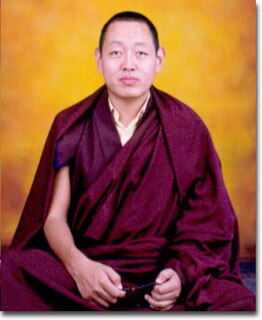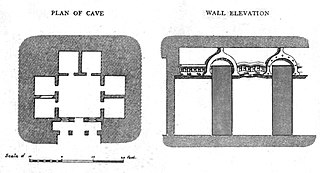Tibetan Buddhism is the form of Buddhism practiced in Tibet where it is the dominant religion. It is also found in the regions surrounding the Himalayas, much of Chinese Central Asia, the Southern Siberian regions such as Tuva, as well as Mongolia.

The Gelug is the newest of the schools of Tibetan Buddhism. It was founded by Je Tsongkhapa (1357–1419), a philosopher and Tibetan religious leader. The first monastery he established was named Ganden, and to this day the Ganden Tripa is the nominal head of the school, though its most influential figure is the Dalai Lama. Allying themselves with the Mongols as a powerful patron, the Gelug emerged as the pre-eminent Buddhist school in Tibet and Mongolia since the end of the 16th century.

Atiśa Dīpaṃkara Śrījñāna was a Bengali Buddhist religious leader and master from the Indian subcontinent. He was one of the major figures in the spread of 11th-century Mahayana and Vajrayana Buddhism in Asia and inspired Buddhist thought from Tibet to Sumatra. In 1013 CE, he traveled to the Srivijaya kingdom and stayed there for 12 years and came back to India. He is recognised as one of the greatest figures of classical Buddhism, and Atisa's chief disciple Dromtön was the founder of the Kadam School, one of the New Translation schools of Tibetan Buddhism, later supplanted by the Geluk tradition in the fourteenth century, adopting its teaching and absorbing its monasteries.

Chöje Akong Tulku Rinpoche was a tulku in the Kagyu school of Tibetan Buddhism and a founder of the Samye Ling Monastery in Scotland.

The sixteenth Gyalwa Karmapa, Rangjung Rigpe Dorje was spiritual leader of the Karma Kagyu lineage of Tibetan Buddhism. He was born in Denkhok in the Dergé district of Kham, near the Dri Chu or Yangtze River.

Labrang Monastery is one of the six great monasteries of the Gelug school of Tibetan Buddhism. Its formal name is Genden Shédrup Dargyé Trashi Gyésu khyilwé Ling.
Dzongsar Khyentse Chökyi Lodrö was a Tibetan lama, a master of many lineages, and a teacher of many of the major figures in 20th-century Tibetan Buddhism. Though he died in 1959 in Sikkim, and is not so well known in the West; he was a major proponent of the Rimé movement within Tibetan Buddhism, and had a profound influence on many of the Tibetan lamas teaching today.
Traleg Kyabgon Rinpoche (1955–2012) was the ninth incarnation of the Traleg tulku line, a line of high lamas in the Kagyu lineage of Vajrayana. He was a pioneer in bringing Tibetan Buddhism to Australia.

Butön Rinchen Drup, (1290–1364), 11th Abbot of Shalu Monastery, was a 14th-century Sakya master and Tibetan Buddhist leader. Shalu was the first of the major monasteries to be built by noble families of the Tsang dynasty during Tibet's great revival of Buddhism, and was an important center of the Sakya tradition. Butön was not merely a capable administrator but he is remembered to this very day as a prodigious scholar and writer and is Tibet's most celebrated historian.

Sakya Monastery, also known as Pel Sakya is a Buddhist monastery situated 25 km southeast of a bridge which is about 127 km west of Shigatse on the road to Tingri in Tibet Autonomous Region.

City of Gold and other stories from the Old Testament is a collection of 33 Old Testament Bible stories retold for children by Peter Dickinson, illustrated by Michael Foreman, and published by Victor Gollancz Ltd in 1980. The British Library Association awarded Dickinson his second Carnegie Medal recognising the year's outstanding children's book by a British subject and highly commended Foreman for the companion Kate Greenaway Medal.

The Jamyang Zhepas are a lineage of tulkus of the Gelug school of Tibetan Buddhism. They have traditionally been the most prestigious teachers at Labrang Monastery in Amdo, Tibet.

Thrangu Monastery, Canada's first traditional Tibetan Buddhist monastery, was officially opened in Richmond, British Columbia, on July 25, 2010 by the Very Venerable Khenchen Thrangu Rinpoche, the worldwide leader of Thrangu Monasteries.

According to Tibetan Buddhism the IXth Minling Khenchen Rinpoche is the successive reincarnation of the Minling Kenrab lineage, co-administrator of Mindrolling Monastery and Head Abbot In-Charge of Ngagyur Nyingma College in India, Vajrayana master, scholar, and teacher.
The Tibetan Aid Project (TAP) is an operation of the Tibetan Nyingma Relief Foundation. TAP was founded in 1969 by Tarthang Tulku—a leading Tibetan master and teacher—to support the efforts of Tibetans to survive in exile and re-establish their cultural heritage. It is a 501 c (3) non-profit organization that primarily focuses on raising funds for the production, shipment and distribution of sacred texts, art and prayer wheels for the World Peace Ceremony in Bodh Gaya, India.
Lama Chime Tulku Rinpoche is a Tibetan Buddhist, Tulku and Dharma teacher. Chime Rinpoche was born in 1941 in Kham, Tibet. In 1959, due to the occupation of Tibet, he was forced to flee to India via Bhutan into exile. Gaining British citizenship in 1965. He taught extensively throughout Europe and established Marpa House, the first Tibetan Buddhist Centre in England. His students include American author and Buddhist nun Pema Chödrön and musicians Mary Hopkin, David Bowie and Tony Visconti.

The Bureau of Buddhist and Tibetan Affairs, or Xuanzheng Yuan was a government agency and top-level administrative department set up in Khanbaliq that supervised Buddhist monks in addition to managing the territory of Tibet during the Yuan dynasty (1271-1368) established by Kublai Khan. It was originally set up in 1264 as an autonomous office named Zongzhi Yuan or the Bureau of General Regulation, before it was renamed in 1288, which was named after the Xuanzheng Hall where Tibetan envoys were received in the Tang dynasty. In the Mongol Empire, Tibet was managed by the Bureau of Buddhist and Tibetan Affairs, separate from the other provinces of the Yuan dynasty such as those governed the former Song dynasty of China, but still under the administrative rule of the Yuan. While no modern equivalents remain, the political functions of the Bureau of Buddhist and Tibetan Affairs might have been analogous to the India Office in London during the British Raj. Besides holding the title of Imperial Preceptor or Dishi, Drogön Chögyal Phagpa, the fifth leader of the Sakya school of Tibetan Buddhism, was concurrently named the director of the Bureau of Buddhist and Tibetan Affairs. One of the department's purposes was to select a dpon-chen, usually appointed by the lama and confirmed by the Mongol emperor in Beijing. Tibetan Buddhism was not only practiced within the capital Beijing but throughout the country. Apart from Tibetan affairs, the Bureau of Buddhist and Tibetan Affairs managed the entire Buddhist clergy throughout the realm, and supervised all temples, monasteries, and other Buddhist properties in the empire, at least in name. According to scholar Evelyn Rawski, it supervised 360 Buddhist monasteries. To emphasize its importance for Hangzhou, capital of the former Southern Song dynasty and the largest city in the Yuan realm, a branch Xuanzheng Yuan was established in that city in 1291, although Tibetan Buddhism took public or official precedence over Han Chinese Buddhism.

Pagbalha Geleg Namgyai is the 11th Qamdo Pagbalha Hutuktu of Tibetan Buddhism and a politician of the People's Republic of China. He is a Vice Chairman of the Chinese People's Political Consultative Conference (CPPCC), and the Honorary President of the Buddhist Association of China. He also formerly served as a Vice Chairman of the National People's Congress, Vice Chairman of the Tibet Autonomous Region, and Vice President of the Buddhist Association of China. As a Tibetan tulku, he is notable for his willingness to work in the Chinese government, except during the Cultural Revolution.
Tsem Tulku Rinpoche was a recognised tulku, an incarnate lama of the Gelug school of Tibetan Buddhism, and the founder and spiritual guide of Kechara House Buddhist Association with its headquarters in Malaysia..



















